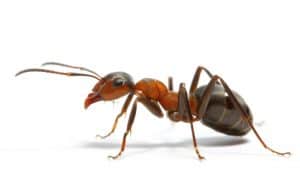Prevent and Prepare for Springtime Pests

Common Springtime Pests
Three key types of pests stay mostly dormant over the winter and emerge in spring, says Jim Fredericks, Chief Entomologist and Vice President of Technical and Regulatory Affairs for the National Pest Management Association: ants, termites and flies. All three lay low when the temperature dips under 50 degrees F. and resurface when the weather is dependably warmer, especially after rainstorms.
“Ants are the No. 1 nuisance pest in the United States,” Fredericks explains. “They don’t completely die out during the cooler months but might be outside of the structure in mulch or landscaping, hiding under rocks or inside using insulation to stay warm.”
Termites can destroy wood in structures year-round but are typically more visible during spring when they emerge to mate and start new colonies, Fredericks says. Flies typically remain dormant all winter but are able to move again and invade structures as temperatures start to rise. “Termite infestations, particularly subterranean termites, build shelter tubes that come out by the building’s foundation. It’s basically a thin mud tube that extends out of the ground a foot or so into the structure. That’s one sure sign of termites,” adds Gene Chafe, General Manager for Senske Services, a landscape maintenance and pest control provider.
Cockroaches and bedbugs are active all year because they’re most active indoors but should still be covered for in spring pest management activities, Fredericks says.
Proactive Steps to Prevent Infestations
The best thing to do is have an integrated pest management program in place that anticipates pests common to your area, inspects accordingly and takes action proactively, Chafe says. Pest management providers can inspect your property on a weekly or monthly basis and identify emerging outbreaks and conditions that encourage infestations, such as moist wood that can attract carpenter ants or leaves blown up against the foundation that provide nesting areas.
In addition to implementing a smart pest management strategy, make sure any screened windows are in good repair to keep flies out. Move garbage cans or designated refuse areas away from the building if possible and keep your compactor room or trash chute clean. Seal entry points and install door sweeps to keep out ants.
Outside, Chafe recommends inspecting your irrigation system while it’s running to check for standing water. Prune bushes 18-24 inches away from the structure and trim trees so that they don’t touch the building. Consider thinner ground cover, as thicker plantings can hide ground-nesting rats and other invaders, Chafe adds.
How to Expel Intruders
Once an infestation has settled in, you need to call in a pest control professional to sort it out before it gets even worse. Practitioners of integrated pest management will start with the least toxic methods to control the population, says Chafe.
Don’t try to take care of the infestation yourself, Fredericks warns. Different insects require different treatments and using the wrong one could backfire. He also suggests checking out the pest guide at pestworld.org to learn more about the habits, habitats and potential threats posed by different species.
Source: buildings.com















 Accessibility
Accessibility